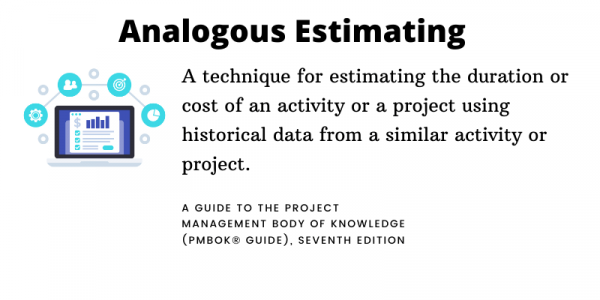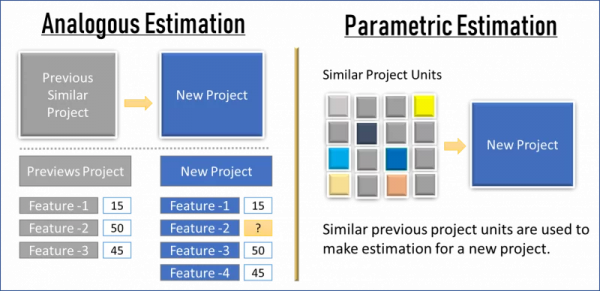Analogous Estimating in project management is an essential estimating technique in project management. It is also known as the top-down estimating technique. It uses historical information and expert judgement to determine the cost, duration and resources required for the project. Although analogous estimating is the least accurate technique, it is quick and used for early project management estimation.
For example, because the tasks were similar concerning duration, one task may be estimated as taking three days, and one task could be estimated as taking nine months. Analogous estimation is the least time-consuming technique, but less reliable, so should only be used with caution.
Analogous Estimating also Known as Top-Down Estimating
The results are more reliable when the project manager has a good grasp of the technical process of estimating time duration, and the historical data used is reliable. If you are using analogous estimation, ensure that the tasks you are using as a comparison have broad similarities and fit naturally into the project plan.
Analogous estimating is used when a few factors have not been controlled in an engineering process. The project manager estimates the time or cost required to complete a task by studying similar tasks done in the past and applying this time and cost estimate to the new task.
The project managers should be experienced in this type of work. The main advantage of this method is that it requires little planning or effort, saving time and money by doing marginal analysis. This method is commonly used early in the project when little information is available, and there are broad similarities between the projects.

The time and cost required to complete a task are essential to project management, especially for the execution phase. For the project manager to accurately predict whether an activity can be completed early or late, they must know how much time it should take to complete the task, given its level of complexity and risk. These factors determine the duration of tasks and the success of project execution.
Analogous estimating efficiently estimates the time required to complete a task. If you consistently misestimate time, you will have wasted money on essential tasks and could have delayed important projects from the due date to the deadline.
Analogous Estimating Technique Example
Analogous estimation helps compare the time needed for tasks with a similar amount of effort and complexity. For example, the project manager used analogous estimation due to governmental regulations to estimate the time required to design a slightly heavier tractor. This particular tractor was just like a standard tractor, except that it was slightly larger and heavier.
The project manager studied the required time to design a similar tractor with slightly larger wheels. The time required to design the heavier tractor was nine months. The engineer used the time required to complete a similar task and estimated the time required to design the heavier tractor.
Bob has recently been promoted as the project head of a software company and must present an upcoming project’s cost and duration to a client. While he has not worked on this type of project before, the agency has completed similar campaigns in the past. He uses analogous estimation to assess the project’s requirements according to past data. He adjusts some variables to account for differences between projects and uses the resulting data in his presentation.
Uses of Analogous estimating in Project Management
The analogous estimating technique is used during the initial stage of project management when limited resources are available, and little project detail is known. This technique is used when the goal is to develop rough order of magnitude.
Analogous Estimating Pros and Cons
Analogous estimating can be performed with limited data and does not require a lot of resources and time. The analogous estimating technique is used for high-level estimation during the initiating phase, which is refined with time as more information becomes available.
The Analogous estimating technique relies on assumptions and historical data; if the assumption or historical data is incorrect, the assumption will be useless. The Estimates calculated using the analogous estimating technique are rough estimates and not very accurate.
Parametric vs Analogous Estimating

Parametric estimating is a technique that attempts to estimate using past data and parameters to help predict how long each task will take. In context, it means that you directly compare tasks when you estimate.
For example, if a wall of area 100 Square feet is to be painted and the cost of painting each square foot is $5, then the total estimated cost would be 100*5 = $500. Therefore the parametric estimation is based on a mathematical model.
An analogous estimation is a form of parametric estimating. It uses comparable past data to give you a fast approximation of how long tasks will take. Analogous estimation is frequently used in project management during initial estimation. This method can save time and money, but it should only be used when the project manager has a good grasp of the technical process of estimation.
For example, if the new project is similar to a previous project done by the organization, then the estimate for the new project can be calculated using the estimates from the earlier projects. The cost of the previous project was USD 50,000, so the estimate for the new project would be 50,000 if a similar amount of work is required.
Expert judgment is essential for analogous estimating. It means that you are getting information from people who are more knowledgeable about the project or have done work like this before and using that to help you estimate how long it will take to complete the task. For example, if you have a shipment of merchandise to be sent, you should get an estimate from the person responsible for sending out similar shipments and products in size and weight. This type of information will help you in your estimating process.
FAQS
Why is analogous estimating less accurate?
Analogous estimating is less accurate when compared to parametric estimating because it reliaes on historical information and assumptions. If the assumptions are incorrect the estimate is useless.
Is analogous estimating accurate?
No, analogous estimating is the least accurate technique because it does not include some factors that could affect the duration of a task. Use this type of estimation with caution and research the chosen technique.
What is the most reliable form of estimating?
Bottom-up estimating is the most reliable form of estimating in project management because it includes all components of the Work breakdown structure (WBS). This method should only be used when there are no constraints on the time spent completing the task.
The analogous method of project estimating is used when little information about the project is available and the project is broadly similar to previously completed projects.
Different companies and organizations tend to use different methods for estimating project duration. An obvious example is government agencies. Regardless of your job type, the government hires people with a lot more experience than private sector companies and organizations. But even in an organization that bills by the hour, there will still be differences between employees who use precise and analogical methods.
